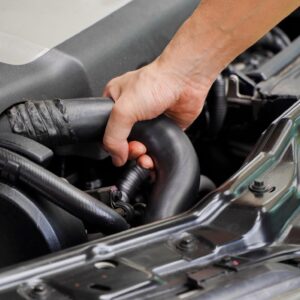Removing hose clamps is often a difficult process. Thankfully, there are dedicated tools that you can use to make the process a lot easier. These are called hose clamp pliers, and there are different designs for different types of hose clamps.
What Are Hose Clamp Pliers?
Hose clamp pliers, also called hose clip pliers, are specifically designed to make pulling out hose clamps easier. Whether it’s the hose clamps along your fuel line or near the radiator, this hose clamp removal tool will help you remove, tighten, or even loosen them.
Hose clamps attach to the different parts of your vehicle, holding down or keeping together different hoses from different lines. If the hoses need to be replaced or if the clamps are damaged or rusted, hose clamp pliers come in handy. They let you grip clamps of various thicknesses and shapes. In addition, they can reach the harder-to-reach areas under the hood or the chassis of your vehicle.
How Hose Clamp Pliers Work
Hose clamp pliers operate by clamping onto a hose clamp. Squeezing a plier’s handle will squeeze the ends of the clamp, which forces it to loosen. The pliers lock into place to prevent the clamp from returning to its original place around the hose. Once the clamp is loosened, you can remove it from where it was once securely set.
Locking a clamp into place allows a similar procedure. You can place the new clamp in place and lock it closed with the hose clamp pliers.

Types of Hose Clamp Pliers
There are a few different types of hose clamp pliers. They’re designed for a variety of uses, and you might find that one type is more suited to your needs than others.
Remote Access Hose Clamp Pliers
Remote access hose clamp pliers have a long line attached to a gripping mechanism at the end. This mechanism is usually designed to work off spring clamps. These particular pliers are useful for reaching the proprietary spring clips in modern vehicles. Gripping the handles of these pliers opens the gripping mechanism on the end of the long cable. Letting go shuts the mechanism, allowing the tool to grab onto the clamps. These flexible hose clamp pliers can also squeeze the ends of clamps, which locks them into place.
Non-Cabled Hose Clamp Pliers
There are a number of hose clamp pliers that don’t come with the iconic cable mechanism. Instead, these offer swivel jaws and other types of clamps. The swivel jaw allows them to reach around difficult corners while remaining rigid.
Specialty Hose Clamp Pliers
Certain hose clamps are made for specific types of clamps. For instance, radiator hose clamp pliers work on flat band clamps. There are specialty hose clamp pliers for coolant lines, gas lines, ear clamps, and band clamps. These pliers will often bear the name of the clamps that they work on.
Hose Clamp Pliers Set
There are also entire sets of hose clamp pliers available for purchase. These sets come with all sorts of pliers to suit all your needs. They’ll often include all the types listed above, with multiple types of specialty hose clamp pliers besides the basics.
Which Hose Clamp Plier Is Best For You?
Keep the following factors in mind when choosing a set of hose clamp pliers:
Intended Use
First, you need to figure out what types of clamps you’ll be using your hose clamp pliers for. If they’re a specialty clamp, make sure to purchase the correct type. For flexibility, go for the remote access hose clamp pliers. If the clamps you’re trying to reach aren’t too far off but you need a swivel jaw, try a non-cabled hose clamp plier. Also consider whether you need your hose clamp pliers to lock. Not all hose clamp pliers come with the locking feature.
Opening Size
If you’re only purchasing one set of pliers, try to get one with an opening size that can adjust to cater to standard hose clamp types. Hose clamps typically have a minimum diameter of 3/8ths of an inch and a maximum diameter of 8 and 7/16ths inches. If you’re buying an entire set, it should contain pliers that work on all common hose clamp sizes.
Cable Length
Remote access hose clamp pliers will have varying cable lengths for their ends. Make sure whatever you buy has a length that reaches into the deepest depth of your vehicle’s engine bay. The longer the cable, the more versatile it is. Most hose clamp pliers will have a cable length that ranges from one to two feet.
Handle
Try to pick a hose clamp plier with a slip-resistant handle. This can help prevent any unsightly accidents. An ergonomic handle will also be more comfortable to hold onto. A slightly curved shape can feel better in your hand than a set of straight handles.
Locking Mechanism
The locking mechanism on your pliers will either be made of steel or aluminum. For a sturdy set, you can invest in steel. However, aluminum is more affordable, although less durable. Heat-treated alloy steel hose clamp pliers are the best, but they’re more costly than other types of pliers. They’re known to be strong and slip-resistant, making them a favored material.

How To Use Hose Clamp Pliers
Using hose clamp pliers is simple. Just position the pliers to fit the outer edges or ends of the hose clamp and squeeze to collapse the clamp. The clamp will then open, allowing you to remove or adjust it. Slide the clamp through the male fitting of the hose it’s attached to before opening the pliers to release the clamp. You can then remove the hose with your hands or a removal hook.
Keep in mind that your vehicle should be switched off with a cool engine before you begin this kind of work. In addition, working with a filled hose can lead to spills, so try to empty whatever reservoir of fluid you’re working with before attempting to remove your hose clamps. If you’re disconnecting coolant hoses in particular, make sure to take off the radiator cap so there isn’t any pressure in the system.
If you are disconnecting coolant hoses, make sure the radiator cap is off so there is not any pressure in the system.
–Anthony Harlin, ASE Certified Master Automobile Technician
Advantages Of Using Hose Clamp Pliers
Now that you’re more familiar with hose clamp pliers, it’s easy to see the benefits of using one. They offer a lot of flexibility and convenience for a task that can be more difficult than it needs to be. While hose clamp pliers are a niche tool, they do their job well and make it much easier to remove hard-to-reach hose clamps.
Need to Remove Hose Clamps? Get Hose Clamp Pliers Online
If you’re going to service your vehicle’s intake manifold or cooling system, you might need hose clamp pliers to remove the fasteners that secure the hoses to the system. Without these pliers, you might have difficulty removing the clips. Or worse, you might even end up damaging them. Luckily, getting hose clamp pliers for the job is easy and convenient here at CarParts.com.
CarParts.com is a trusted source for all sorts of vehicle parts and accessories, including hose clamp pliers. We source our accessories from the most trusted aftermarket brands, so you know they’re high quality and built to last. Our hose clamp pliers are also competitively priced, so you can service or repair your vehicle without breaking the bank.
Don’t conduct repairs without the right tools. Browse our selection of hose clamp pliers and enjoy our fast shipping when you shop at CarParts.com today!
Any information provided on this Website is for informational purposes only and is not intended to replace consultation with a professional mechanic. The accuracy and timeliness of the information may change from the time of publication.






























